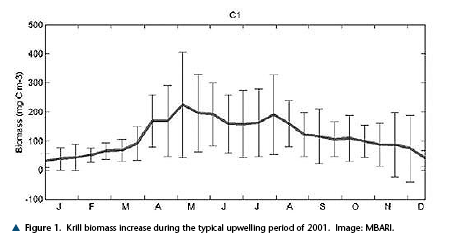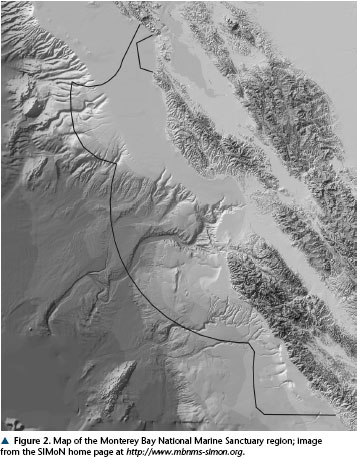Research Technical Report
A PDF Version of the article is available here: 070604esm.pdf (184KB) |
Upwelling on the Central California Coast: An Introduction to the Sanctuary Integrated Monitoring Network
Pederson, J., and J. Holmgren (July 2004)
The Monterey Bay (California) National Marine Sanctuary is an internationally recognized location for marine research, resource management, and policy. Over forty institutions and organizations in the greater Monterey Bay area are currently conducting research, which includes long-term monitoring programs that are essential to the further understanding and health of the marine ecosystem.
The Sanctuary Integrated Monitoring Network (SIMoN) serves as a focal point to integrate the existing monitoring programs and to identify gaps in information. SIMoN makes the monitoring data available to managers, decision makers, the research community, and the general public. More information on SIMoN can be found at the website: https://sanctuarysimon.org.
One of the major studies in the Sanctuary that SIMoN serves is that of the central coastal upwelling, which typically begins in March and ends around July. The effects of this seasonal occurrence can not only be seen in marine organisms such as phytoplankton, zooplankton (Figure 1), and the fish and marine mammals that feed upon them, but in the weather as well. The traditional foggy summers on the Central California coast are attributed to the physical interaction between the warm summer air and the newly upwelled cold ocean surface waters. As these waters cool the summer air, moisture collects and forms the coastal fog common to the Sanctuary.
Scientists have developed instruments and technology to detect upwelling at the level of the primary producers. One instrument, the fluorometer, detects pigments, primarily chlorophyll, that phytoplankton use to perform photosynthesis. Chlorophyll measurements are used by oceanographers to determine the level of biological productivity throughout the food chain. Satellite imagery is used to detect pigmentation of the phytoplankton which reveals the quantity and distribution of phytoplankton over a given area of the ocean.
In the Monterey Bay National Marine Sanctuary (Figure 2) a variety of research groups are dedicated to collecting and analyzing information about the upwelling process. The UC Santa Cruz Center for Integrated Marine Technologies (CIMT) is collecting data on wind, primary productivity, krill, ocean temperature, seabirds, whales, and other components of the upwelling system. This data is analyzed and integrated to produce an enhanced understanding of the relationship between primary productivity and higher trophic level organisms such as fishes, marine mammals, and seabirds.
The Monterey Bay Aquarium Research Institute (MBARI) also studies coastal upwelling in the Sanctuary. The Simulations of Coastal Ocean Physics and Ecosystems (SCOPE) project at MBARI assimilates data from satellites and ocean sensors to model the interconnected physical, chemical, and biological processes associated with upwelling. These models will help understand the distribution of marine mammals, seabirds, and fish during a period of upwelling, and will help resource management as well as direct future research projects and observational efforts.
With so many marine organisms utilizing the upwelling process for food and reproduction, it is important that Monterey Bay National Marine Sanctuary staff understand the dynamics of this annual process in order to effectively manage these interconnected resources during this time of the year. Fortunately, there are programs such as CIMT and SCOPE that are dedicated to enhancing the Sanctuary's knowledge of this incredible oceanic phenomenon.


